16 Peruvian foods (and drinks) you must try
Hey folks – my apologies for the blog being so thin lately. I’ve been on the road – a lot – and I can’t seem to justify spending my days sitting in a hotel room blogging. We’ll return to daily posts next week, I promise. In the meantime, read on about Peruvian foods you must try. And for your own safety, do not consume this post on an empty stomach.
As some of you may have noticed, I don’t really do much research on my travel destinations, except when it comes to cuisine. I left for Peru with a vague understanding of who created Machu Picchu, but I was able to rattle off the local desserts like an expert. This concerns me slightly. I have this fear that, should aliens ever abduct me (and let’s face it: this is a highly probable likelihood) they will ask me all sorts of questions about other parts of my planet. And most of the time, I WILL HAVE NO CLUE WHAT TO SAY right up until the topic of food comes up, at which point I will be some sort of savant. Governmental structure of Peru? No clue. But they have these fantastic dulce de leche sandwich cookies called alfajores (I’ve eaten enough in one sitting to risk diabetic shock). Iceland? I can’t remember anything about my trip there except for that yogurt dessert they kept feeding us. And my usually reply to when anyone mentions the U.K. is to drool and mumble “sticky toffee pudding” with a glazed look in my eye.
Gah. I will be so useless if the aliens are planning some sort of governmental takeover. How embarrassing. And completely likely, as I am sure you will agree. But fortunately I’m more often asked questions that pertain to travel, and not the domination of the human race. So if you plan on staying earthbound, and make your way to Peru, here’s what you should munch on while you’re there.
- Alfajores. I first learned about these delightful sandwich cookies on a chilly day, sitting in a restaurant outside of Port Charles, New York. Rich dulce de leche sandwiched between buttery, not-too-sweet shortbread cookies, dusted with powdered sugar. Remember Oreos? Well, you won’t after you have one of these. Heck, you’ll barely remember your own name.
–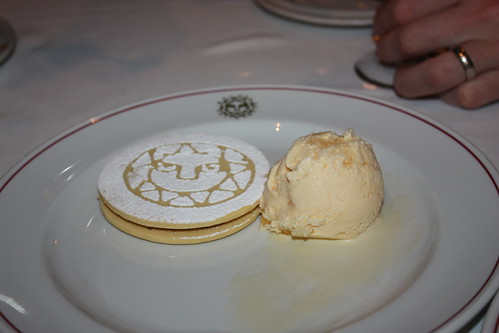
See those fingers in the background? Pretty sure I bit them in the frenzy of shoving this thing into my face.
–
- Cuy. Yes, it’s guinea pig. It’s also a very traditional mainstay of Peruvian cuisine. If the idea of munching on one of these cute, furry fellows doesn’t horrify you, I suggest you try it. The meat is sweet, dark, and flavorful. And you can totally freak your friends out with the story.
–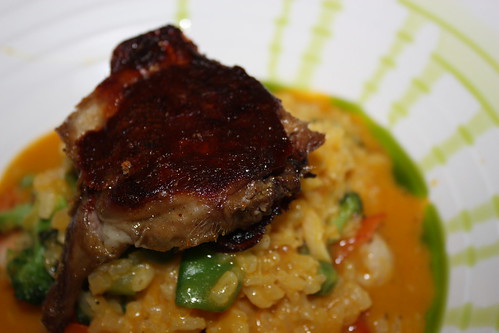
I'm sure this will horrify a lot of you. But it was really, really yummy.
–
- Mate de Coca. The coca plant has some really bad press stateside – yes, it is used to make cocaine. But that requires a lot of leaves (something like 600 kg of the coca plant make 1 kg of cocaine), processed with gasoline and numerous chemicals. In the Peruvian Andes, the leaves are chewed or brewed into a tea. It tastes like a grassy green tea, and no, it won’t give you the shakes or make you feel crazy, but it will help alleviate the nausea of high-altitude sickness.
–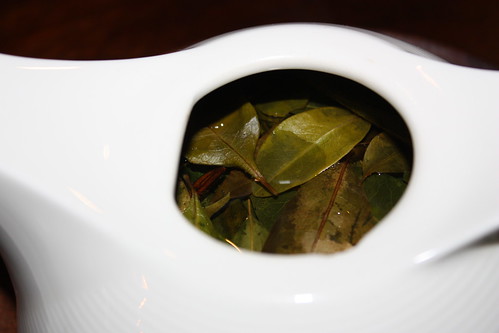
Coca leaves stewing in a pot.
–
- Llama. Alpacas are incredibly important in the Andes – they’re used to the rough terrain, and they produce wool which is used to make clothing and textiles. It’s not nearly as common as cuy or chicken, so my hubby jumped at the chance to order it when he saw it on a menu. The meat is tender and light – I described it as “white meat beef”. He enjoyed it a llot. (GET IT? I AM CLEVER.)
–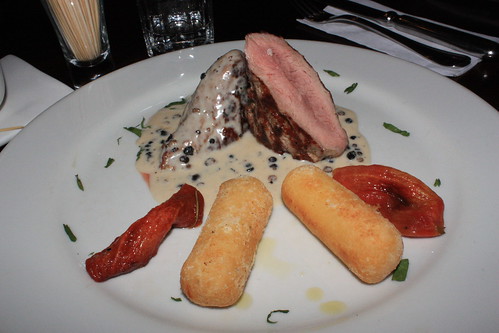
Rand's llama entree with some potato croquettes in the foreground.
–
- Lomo Saltado. Peruvian cuisine is like a Benetton ad – a colorful mix of cultures and ethnicities. Lomo saltado (literally, “jumping beef”) is a great example of this. The dish is a Chinese-style stir-fry of vegetables and meats, seasoned with soy sauce and served over fried Peruvian potatoes. My husband craves it fortnightly.
–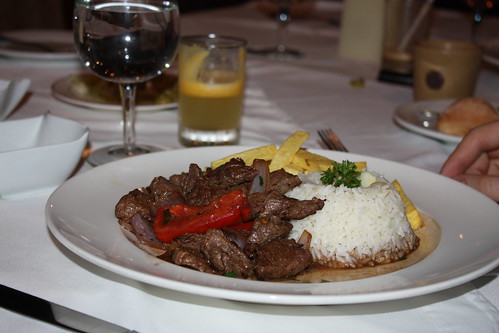
Seriously, Rand asks for this all the time, but I don't know how to make it. OUR MARRIAGE IS A SHAM.
–
- Chicha Morada. Note that is distinct from “chicha” – the alcoholic drink made from chewed up, fermented corn. Chica morada is a dark, sweet beverage made from purple maize. It tastes like grape juice, minus the refreshing tartness (so … raisin juice?). While I’m not a huge fan of the stuff, the frozen variant that I had was fun to try.
–
It really was pretty - I just wish it had been a bit more tart.
–
- Anticuchos. While anticuchos can refer to any type of grilled meat on a skewer, you’ll commonly find beef hearts prepared in this way. The meat is rich and velvety. As delicious as they are, you likely won’t eat more than one before feeling your own heart clench.
–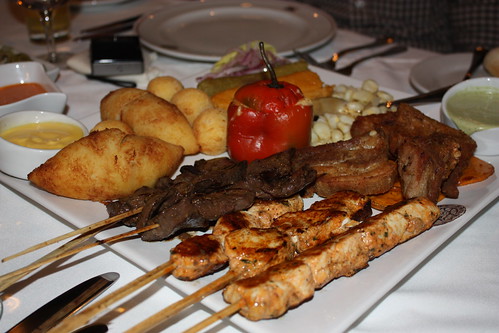
Anticuchos of various meats with a rocoto relleno (stuffed pepper) in the background.
–
- Pisco Sour. Pisco – a grape grappa that originated in Peru – is mixed with lemon, sugar, bitters, and an egg white (which is how any good sour is made). The alcohol goes down alarmingly easy, with very little bite. Combined with the high altitude (which increases the effects of alcohol and the time it takes to feel it), this drink can be very, very dangerous.
–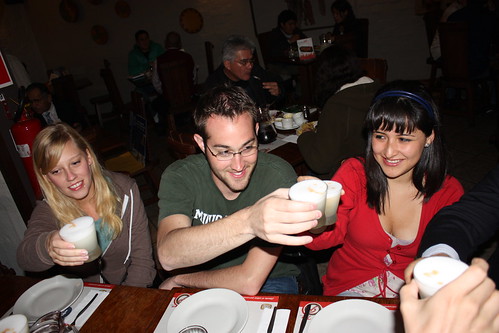
Photos of us taken AFTER the consumption of said sours have been diplomatically omitted from this post.
–
- Cebiche (or ceviche). This dish is usually served as an appetizer. Fresh raw fish is cut up and tossed with lemon or lime juice – the acid of which “cooks” the fish, and is combined with onions and chili peppers. Peru has a substantial Japanese population, and you can often see modern twists on sushi involving cebiche.
–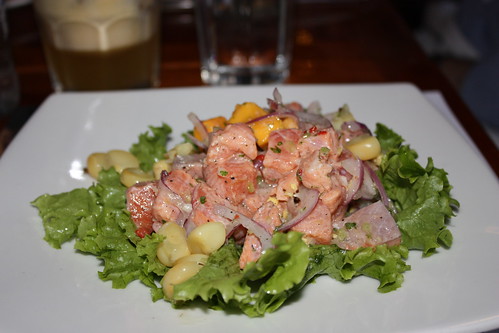
And halfway through this post I realize: I am starving.
–
- Picarones. Three words: fried pumpkin donuts. The crispy, golden crust of these fritters is usually softened by dipping them in a caramelized honey sauce. They taste like a fall carnival.
–
I refuse to admit how many of these I ate. It was many.
–
- Pulpo. Octopus (“pulpo” in Spanish) is by no means unique to Peru, but you will see this cephalopod on menus throughout the country, either grilled or occasionally in cebiche. If you are a fan of squid (and really, who isn’t?) this dish is definitely worth trying.
–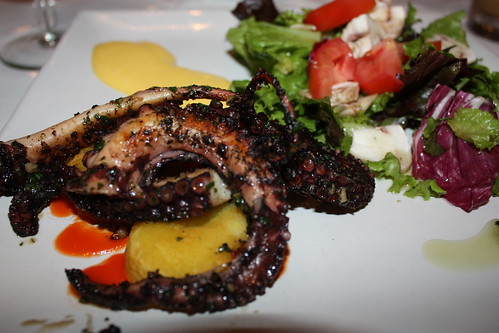
Mmm ... tentacle-y.
–
- Aji de Gallina. When this dish arrived at our table – consisting of tender chunks of chicken stewed in a rich yellow sauce, absolutely no one could tell us the ingredient list. Apparently it is long and varied (not unlike a mole recipe). The dish takes a while to prepare, too – but the result (a creamy concoction that is cheesy, nutty, and spicy all at once) is worth it.
– - Rocoto Relleno. The Peruvian take on the stuffed pepper is not kidding around. Forget the sweet bell variety that we’re used to – in Peru, they use a slightly spicy pepper that delivers a bit of a kick. Fillings variety, but it’s usually a mix of ground meats and vegetables.
– - Chifa. Owing to its large immigrant popultaion, Chinese food (known as “chifa”) is a specialty in Peru. Sadly, we didn’t get to try it, but we did enjoy a number of dishes that had Chinese influences (including the aforementioned Lomo Saltado).
–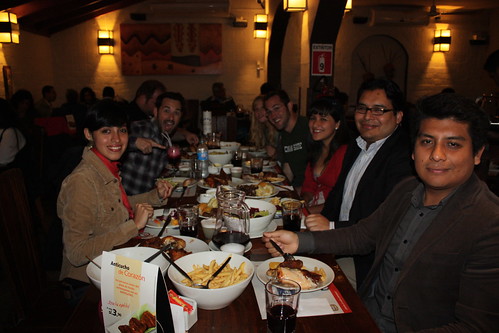
So we didn't get chifa, but it's not like we starved.
–
- Lucuma. This peculiar green fruit is not common in the U.S., but the flavor is so prevalent and delicious that in Peru, your ice cream choices will often be chocolate, vanilla, and lucuma. The fruit has a mild, caramel-flavored sweetness to it – try it in ice cream or (like we did) in a cake.
–
Two slices of cake (lucuma and chocolate) and my dorky husband. I've never been happier.
–
- Inca Cola. Created in Peru in the 1930s, this drink is so popular it outsells all other soft drinks in its home country. The color is a quasi fluorescent yellow and the taste is like a less-sweet Mountain Dew. I didn’t really like the stuff (but then again, I’m not a big soda drinker) but a few people in our party were hooked.
–
I call this color "electric pee."
–









Leave a Comment